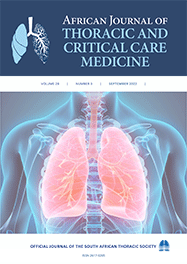Original research

The diagnostic gap: Characterising the profile of undiagnosed infectious tuberculosis patients in the community
Abstract
Background. In tuberculosis (TB)-endemic countries, about half the total TB caseload remains undiagnosed within the community. The proportion of such patients that can potentially transmit the disease has been poorly characterised, and there is insufficient data to inform on strategies to target potentially infectious TB cases in the community.
Objective. To characterise the nature and profile of smear-positive patients diagnosed with TB in the community.
Methods. We analysed data from culture-positive TB cases in the community during the course of an intensified case finding (ICF) study. The parent study was a randomised controlled trial comparing conventional and novel diagnostics for ICF in communities in Cape Town, South Africa and Harare, Zimbabwe, where trained healthcare workers screened patients at transmission hotspots. The results of the parent study are reported elsewhere.
Results. A total of 2 261 persons were screened and 875 (39%) met the criteria for diagnostic testing. A total of 53/630 (8.4%) had confirmed tuberculosis. Smear microscopy detected 22/53 (42%) of the culture-positive patients. The specificity, positive predictive value (PPV) and negative predictive value (NPV) for smear microscopy were 98.4%, 70.0% and 95.3%, respectively. No clinical or demographic variable predicted smear positivity. Only decreased culture time-to-positivity was associated with smear grade (odds ratio 0.93, 95% confidence interval 0.91 - 0.96; p<0.001).
Conclusion. A considerable proportion of patients with undiagnosed TB in the community (almost half) were smear positive and hence potentially infectious. Interestingly, neither HIV status nor symptoms identified those patients who were potentially infectious, despite them having a higher mycobacterial burden.
Authors' affiliations
Greg Calligaro, Division of Pulmonology, Department of Medicine, University of Cape Town, South Africa; and Lung Infection and Immunity Unit, University of Cape Town Lung Institute, Groote Schuur Hospital, Cape Town, South Africa
A Esmail, MD, FCP, Cert Pulm
T Mnguni, Division of Pulmonology, Department of Medicine, University of Cape Town, South Africa
L Mottay, Division of Pulmonology, Department of Medicine, University of Cape Town, South Africa
K Dheda, Division of Pulmonology, Department of Medicine, University of Cape Town, South Africa
Full Text:
Keywords
Cite this article
Article History
Date published: 2016-12-19
Article Views
Full text views: 1385
Refbacks
- There are currently no refbacks.
African Journal of Thoracic and Critical Care Medicine| Online ISSN: 2617-0205
This journal is protected by a Creative Commons Attribution - NonCommercial Works License (CC BY-NC 4.0) | Read our privacy policy.
Our Journals: South African Medical Journal | African Journal of Health Professions Education | South African Journal of Bioethics and Law | South African Journal of Child Health | Southern African Journal of Critical Care | African Journal of Thoracic and Critical Care Medicine| South African Journal of Obstetrics and Gynaecology |



.jpg)